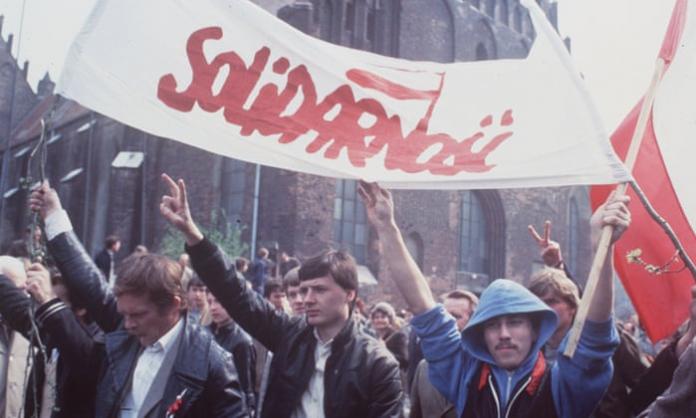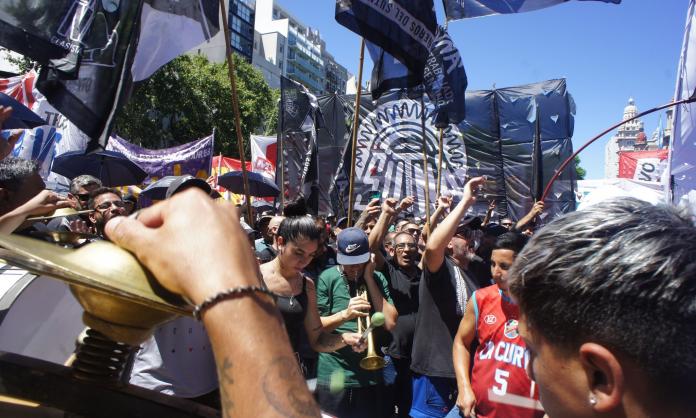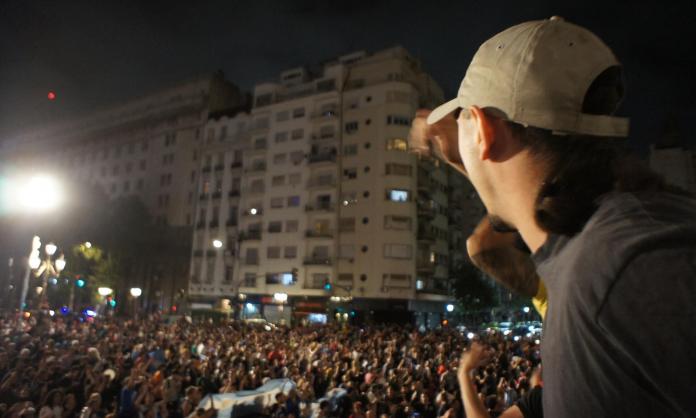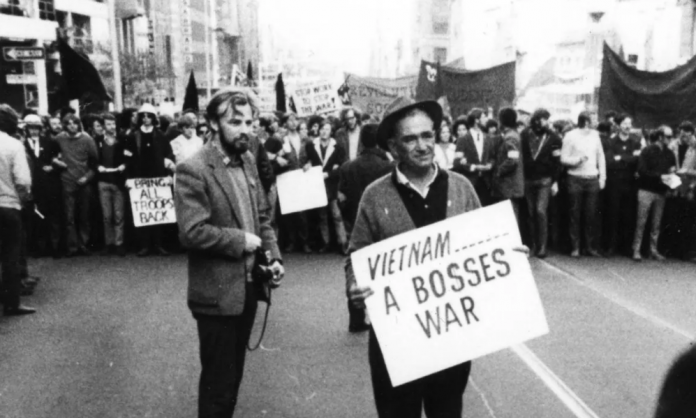A little over 40 years ago, from August 1980 until December 1981, the Stalinist regimes of the Eastern Bloc were challenged by an insurgent working-class struggle in Poland. The Solidarność movement (Polish for Solidarity) was a workers’ revolution, made all the more significant for arising in a so-called socialist state.
The revolution began as a strike of 17,000 workers at the Lenin Shipyard in the northern city of Gdańsk on 14 August 1980. This strike was to defend a militant activist and crane driver, Anna Walentynowicz, who had been fired for trying to organise a union independent of state control. The shipyard occupation occurred in the context of a national strike wave launched by workers resisting government efforts to make them pay for a deep recession. But the movement in Gdańsk proved to be different from the struggle in the rest of Poland.
At Gdańsk, the workers not only defeated the victimisation of Walentynowicz and won a significant pay rise but, at the urging of Walentynowicz and her fellow union activist Alina Pienkowska, they stayed on strike in solidarity with other factories. The Gdańsk strike committee adopted 21 demands, which ranged from the establishment of independent unions and the right to strike to freedom of speech, release of political prisoners, a reduction in the retirement age, the end of Saturday work and access to day-care for working mothers.
Gdańsk became the centre of an Inter-Factory Strike Committee (Międzyzakładowy Komitet Strajkowy, MKS), workers from across the region travelling to take part in mass assemblies in the shipyard. Similar bodies were set up across the country; by the end of the week, three million workers across 3,500 enterprises were on strike. The regime had little choice but to compromise, agreeing to all 21 demands. This was the first time that an Eastern Bloc regime was forced to acknowledge an independent trade union. On September 17, 1980, MKS called the first national conference of the new union, which adopted the name Solidarność.
But Solidarność became more than a trade union. “It was a workers’ movement for justice and freedom ... [which] drew every oppressed, downtrodden and exploited section of Polish society behind its banner”, British socialist Colin Barker wrote in his book Festival of the Oppressed: Solidarity, Reform and Revolution in Poland 1980-1981. Pienkowska, as recorded in the film Man of Iron, expressed the views of millions of Poles when she said of her experience at Gdańsk: “Here in the shipyard I stopped being afraid, stopped running away, and became a real person.”
A month after its foundation, the membership of Solidarność was estimated to be 10 million people, around a third of the population of Poland. Stanislaw Kania, leader of the Stalinist Polish United Workers’ Party, was correct when he said “there is no room for two power centres in this country. Double power has never been and could never be a system of organisation of public life”. Poland represented a classic example of a revolutionary, dual power situation. Either the incipient workers’ power represented by Solidarność would conquer the bureaucratic capitalist state presided over by Kania, or it would be conquered by it.
Polish nationalism, in a similar manner to other oppressed nationalities such as the Irish, was indelibly connected to Catholicism. Poles clung to their faith as a marker of national difference. They faced the efforts of the Russian monarchy to implement Russification and to privilege the Russian Orthodox Church throughout the nineteenth and early twentieth centuries. And following the installation by the Soviet Union of the bureaucratic dictatorship of the Workers’ Party in 1945, Catholics again were persecuted.
But the church wanted power and influence and was willing to compromise with the authorities, even “socialist” ones. Thus, Archbishop Stefan Wyszynski called for the end of the occupation at Gdańsk in August 1980. He was unsuccessful, but workers on the strike committee were desperate to have religious authorities back their actions and organised Mass in the shipyard.
Polish workers also had their own tradition of militant class struggle. Polish revolutionary socialism, which had become a sizeable force leading up to the First World War and in the years afterward, was dismembered by Stalin. Most of its leaders were executed and the party disbanded in 1938. Despite the physical extermination of the revolutionary tradition, dissident student members of the Stalinist United Workers’ Party, inspired by the 1956 revolt in Hungary, published an “Open letter to the party” in 1964:
“It is said that the bureaucracy cannot be a class, since the individual earnings of its members do not come anywhere near the earnings of capitalists ... This is quite wrong ... The property of the bureaucracy is not of an individual nature, but constitutes the collective property of an elite which identifies itself with the state ... its class character [depends] only on its relationship—as a group—to the means of production.”
The only way to achieve “workers’ full democracy in the state”, which was necessary for genuine socialism was “the overthrow ... of the bureaucracy’s class rule”, wrote the letter’s authors, Jacek Kuron and Karol Modzelewski, who were thrown into prison. Nonetheless, left-wing anti-Stalinists continued to organise and Poland’s workers continued their struggles. Mass strikes, including at Gdańsk, were gunned off the streets in 1970 and 1976. It was following the 1976 strikes that the Workers’ Self-Defence Committee (Komitet Obrony Robotnikow, KOR) was established to organise solidarity for victimised workers. KOR was the political and ideological forerunner of Solidarność; KOR activists such as Walentynowicz agitated for class struggle and independent trade unions.
Tragically for the fate of the Polish revolution, by the time KOR was set up, the politics of its leaders had shifted from that of the “Open letter”. Kuron, Modzelewski, Adam Michnik and other ex-student dissidents concluded from the Russian military intervention in Czechoslovakia in 1968 that revolution was impossible against the armed might of the Soviets. Influenced by exiled academic Leszek Kolakowski’s 1971 article “Theses on hope and despair”, KOR advanced the theory of the “self-limiting revolution”. This meant that while they welcomed a mass revolt, it had to be controlled and directed towards the reform, rather than the overthrow, of the state.
Rather than challenge state power, which they believed would end only in violent repression, activists encouraged community self-organisation efforts. Through free trade unions and other voluntary associations, society could be reformed. Rather than the goal being socialism, the movement sought to emancipate “the society” from “the power”. These arguments echoed the classical syndicalist view about organising the new society “from within the shell of the old”.
When the revolution came, it was not “self-limiting” but behaved like a flood that burst all barriers placed before it. Solidarność’s national leaders limited the movement to a one-hour general strike in October 1980 to pressure the government to recognise the union. But all across the country, workers, peasants and students were taking their own action. Their strikes and occupations generally concerned issues of pay and demands to purge local Stalinist authorities and defund the police, or to defend militants being persecuted.
Nearly 5,000 workplaces participated in strike action by the time of the national strike, from sectors ranging from rail, steel, textiles, sugar processing and more. “In the eyes of the people, the new trade unions should do everything; they should fill the role of trade unions, participate in the administration of the country, be a political party and act as a militia ... and that’s a great problem for us”, KOR activist Bogdan Borusewicz, complained.
Inspired by the workers, peasants and students demanded their own independent unions, and prisoners rioted for more food. Localised general strikes took place in the city of Lodz and the region of Bielsko-Biala. A decisive confrontation occurred in March 1981 in the city of Bydgosczc, after 200 police attacked a peasant occupation. Half a million workers struck, followed by a national four-hour strike demanding the government drop charges against the peasants and punish the police. This time, a Solidarność national delegates’ meeting made an ultimatum to the government—if it did not carry out the union’s demands, there would be an unlimited general strike and workplaces would be occupied.
As the pressure continued to build, church and state worked to threaten and undermine the strike. The leaders of Solidarność feared that any militant action would result in repression. Lech Walesa, a Gdańsk shipyard electrician and KOR activist who had been elected chair of the praesidium of Solidarność, announced that the strike was over following some minor concessions from the regime. While many leading members of Solidarność protested the decision, Walesa’s authority was decisive.
While the regime was granted a reprieve, increasing divisions opened within Solidarność between an increasingly church-influenced moderate faction around Walesa and a left wing wanting to maintain the 21 demands of the Gdańsk strike. While the leftists were more or less consistent in their opposition to concessions and support for greater democracy in Solidarność, as against the “dictatorship” of Walesa, they continued to accept that the revolution needed to be “self-limiting.” Only a small number of leading people held to the politics of Kuron and Modzelewski’s “Open letter”.
While Solidarność’s leaders were either unwilling or unable to provide leadership to the revolt from below, workers driven by hunger from the mounting economic crisis continued to revolt. Hunger marches and strikes swept the country anew in July. By September, there were regional strikes in two-thirds of Poland’s provinces. The Solidarność leaders played the role of firefighters for the regime, constantly putting out the flames of rebellion by urging workers to accept sacrifices for the good of the nation. The result was that disenchantment grew not only with the regime but with Solidarność.
While Solidarność failed the test of leadership, the regime rallied around the idea of a military strongman taking decisive action to crush the workers’ movement. General Wojciech Jaruzelski became secretary of the Workers’ Party in October and deployed soldiers into rural areas across the country, ostensibly to aid in the distribution of food. At the same time, police repression intensified, with a student occupation in Warsaw broken up by 300 police. At the start of December, Jaruzelski announced that strikes would soon be banned.
With repression clearly imminent, Solidarność moved towards a confrontation with the state. A general strike was called for 17 December. This time, the goal was the formation of a provisional government led by Solidarność, which would then hold democratic elections. Some factories began to organise workers’ militias. But in reversing course, the Solidarność leaders could not easily summon the spirit of revolt which they had spent fifteen months trying to exorcise. On 13 December, the military arrested the entire national leadership of Solidarność as they met to determine the course of the revolt. Timothy Garton Ash, a professor of European studies at Oxford University, described it as no less than the Polish Army invading “their own country”.
Across Poland, communication lines were cut and roadblocks were set up. Five thousand activists were arrested. The military seized control and Jaruzelski declared a “state of war”. The church further dampened the resistance, the archbishop arguing that “the exceptional nature of martial law is dictated by a higher necessity” and accusing Solidarność of threatening “a fight of Pole against Pole”. The general strike wasn’t stopped, but while workers occupied factories across the country, they were isolated and picked off one by one. Mass rallies of tens of thousands opposed martial law in several cities, but the movement now confronted a regime prepared to fight. The White Terror that Jaruzelski unleashed resulted in tens of thousands of arrests, while the military suppression of strikes left thousands wounded and 91 dead.
Colin Barker’s political analysis of Solidarność’s rise and fall remains the best available. He explained that while the efforts of KOR in agitating for workers’ resistance to the regime took the struggle forward to a point, once Solidarność was established, its commitment to a “self-limiting revolution” proved a barrier. The bureaucratic dictatorship was never going to share power or agree to some kind of compromise with an independent mass workers’ movement. The failure of Solidarność’s leaders to come to grips with this meant that they were never prepared for a revolutionary struggle, which would have entailed attempts to win over sections of the armed forces, an earlier effort building workers’ militia and a greater preparedness for the inevitable repression that the union faced.
The tragic postscript of Solidarność’s failures of 1980-81 was written in the years of the collapse of the Eastern Bloc. Walesa and a handful of the old movement’s other leaders reclaimed the title of Solidarność, but this time bereft of the mass organisation from below. Without any clear conception of independent working-class politics, these leaders moved towards Catholic liberalism. Walesa became be the first elected president after the end of “communism” in 1990. Kuron, the ex-Marxist, became his minister of labour. In the words of Gdańsk shipyard worker and former Solidarność leader Andrzej Gwiazda, the new government presided over “closures of industries, massive job cuts, waste of the national wealth by rigged sell-offs [and] corruption”. This meant that the memory of Solidarność as a movement of working-class self-emancipation has largely been buried, and the younger generation of Poles “treat with disbelief the stories of total commitment and dedication of millions of Poles in the fight for freedom and democracy under this banner”. It is up to the socialists of today to study the old Solidarność, with its inspiring rebellion and painful lessons.










